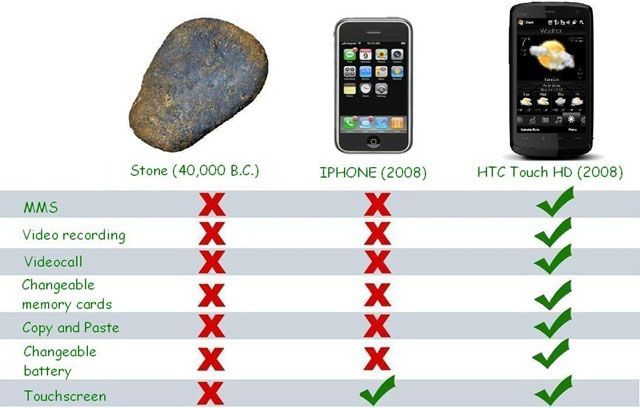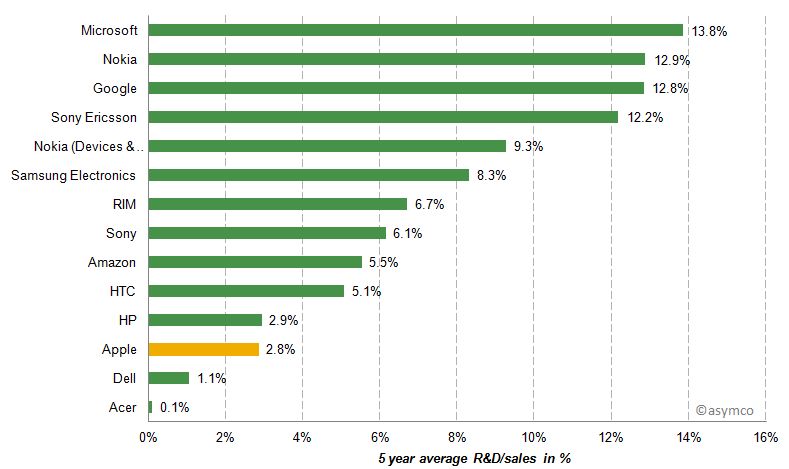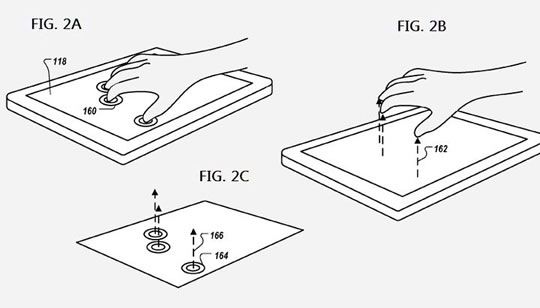Yesterday, the verdict was issued in the famous Apple v. Samsung lawsuit in the USA. The California jury ruled that Samsung had violated six Apple patents and established a compensation of 1.05 billion dollars. In this post, we will analyze the reasons for the lawsuit and the consequences of this verdict.
Reasons for the Lawsuit
The reason for Apple’s lawsuit against Samsung is the infringement of patents owned by Apple. Of the 7 patent claims made by Apple, infringement has been recognized in the use of 6 by different Samsung products. I will summarize the content of these 6 patents below:
- Design of the iPhone, i.e., square, black, and with rounded edges.
- Displaying programs with square icons and rounded corners.
- Tapping with a finger on an image or document to enlarge it.
- ‘Pinching’ with two fingers on the screen to zoom in/out.
- ‘Bounce’ effect, i.e., when you scroll up/down a document and reach the end, the screen bounces.
On the other hand, the verdict dismissed Apple’s claim regarding the Galaxy Tab, which alleged that it copied the iPad, so it will not be subject to any restrictions. The verdict also does not affect the Galaxy S3, which can continue to be sold normally. Additionally, Samsung’s counterclaims against Apple for the improper use of its radiofrequency chip patents were also dismissed.
Consequences of the Verdict
First of all, it is logical that Samsung will appeal the verdict. However, it is highly unlikely that it will be modified. On the other hand, Apple will request a legal mechanism to consider Samsung’s offense as ‘special damages,’ which could triple the amount to be paid. It is also highly unlikely that the court will grant this treatment.
Additionally, Apple will request the blocking of the sale of Samsung’s latest generation mobile phones, i.e., Samsung Galaxy S2 and Nexus (the Galaxy S3 will be exempt). Based on recent US court rulings that have set a jurisdiction in the opposite direction, it is foreseeable that the withdrawal of the products will not be granted, but it would open the door for Apple to seek future compensation for the use of its patents.
As for the economic aspect, Samsung can deal with the 1.05 billion dollar lawsuit without major problems, as it has earned profits of 3-4 billion dollars in the last three months alone (only in profit, the sales volume was much higher). Therefore, although it is a big economic blow, it does not lead to its ruin.
The biggest problem for Samsung is the uncertainty regarding the sale of its products in the USA, including the possibility of completely losing the US market, and the need to develop new interfaces for its products, something almost impossible due to the restrictive and general nature of the patents.
As for the business image, the effects are indeterminate, as the position of both Android and Apple can be harmed or reinforced. This will depend on each individual user and how both companies manage the situation in the coming weeks, so it is not possible to guarantee the overall effect.
How Innovative Was the iPhone?
I don’t want to turn this post into a small technology museum, but it seems that in the debate forums, arguments in favor (or against) are focusing on the innovation (or lack thereof) of the iPhone. In my opinion, this is not the underlying problem, but this post would not be complete without addressing the issue.
The following images show a little bit of the evolution of touch technology. They are just examples, based on my personal experience (I have owned almost all of them). And that, even though the iPhone brought touch screens to the general public, it does not mean that the rest of us didn’t know that they existed long before, and the steps that the market was going to follow. You can click on the images to enlarge them but don’t do it with your finger or Apple will sue you.

One of the first touch mobiles to be commercialized was the Ericsson r380s, on the left of the image, released at the end of the 90s. It could be considered the driving force behind touch screens in mobile devices, despite its prohibitive price. On the right of the image is the TSM100, a mobile released a few years later, with a selling price of 150€. It could be considered the first affordable touch mobile for the public.

In the upper image, you can see a Palm Tungsten T3 that I bought in 2003. These devices, the PDAs, are the predecessors of today’s smartphones. They could be used as an agenda, to send emails, read documents, open Excel sheets, synchronize data, etc. In this device, we observe the grid of programs already at its peak.

At that time, another great ‘war’ between companies took place. This time it was between Microsoft and Palm for dominance in the PDAs. Despite Palm having superior models, Pocket PCs ended up prevailing, so I ended up buying the HP HX2790, which you can see on the top in its docking station. On the left, you see an example of its application menu where the grid of programs appears (oh, yes!) again.

Finally, I present to you the HP TX2000, a Tablet PC that I bought in 2007. Its Wacom touch screen had a double layer, so you could interact with your finger or with a pen housed in its base. When you brought the pen close, the ‘normal’ touch screen would deactivate, so you could rest your hand and draw as if it were a notebook. Without a doubt, it is the best laptop I have had and the best experience with a touch device.
And finally, we come to the iPhone, which was launched in June 2007 in the USA, and in 2008 in the rest of the world. Based on what we have seen so far, you can probably guess that it did not bring anything unexpected or surprising to industry experts, but rather the logical evolution of devices. However, we cannot deny that they exceptionally implemented the user interface, abandoning the use of a pen once and for all. On the other hand, the iPhone was heavily criticized for the absence of many features available in other mobile phones.

Personally, I am the proud owner of a Samsung Galaxy S2, and it is my favorite ‘Geek’ device. I find it technologically superior, allowing me to modify its operating systems and configurations, customize it, change the ROM, root it, etc. I don’t particularly like how the phone comes ‘out of the box’, particularly displeased by the performance and appearance of Samsung’s interface, TouchWiz (next image). But, at this point, do you really think that the grid of apps was Apple’s idea? (and can you tell me if you see square icons with rounded corners?)

Finally, for those who say that Apple is the ultimate innovative company and the main driver of the technology industry, it is worth mentioning that the processors for iPad/iPhone are manufactured by Samsung and the processors for their laptops by Intel. Their iCloud service is hosted on Microsoft Azure servers. It is the company that gets the highest sales margin (profit/cost) for its products and invests the least in R&D (R&D investment/revenue).
 tesy of: Amyco
tesy of: Amyco
The Underlying Problem
In the previous section, we have stated that innovation is not the underlying problem of this lawsuit. The iPhone contributed to the evolution of touch technology and, above all, to its popularization. However, the market is large, and it is normal for evolution to be joint and for trends to exist. No company can ‘shield’ a sector and prevent other competitors from entering.
The problem is the US patent system, which is very different from that in other parts of the world, such as Europe, Australia, or South America. US patents allow for the patenting of a concept, a slogan, or even a word. There is no need for a specific technological development or to present a working prototype.
To highlight the absurdity of the concept, let’s say that I have spent 4 years at my university researching an idea. We have done theoretical studies, published some articles, conducted experiments, and we are now in the process of creating the first prototypes. Well, some enlightened genius from a multinational company can have the same idea, go to the US Patent Office, pay a huge amount of money, and register the concept. Without development, without research, without prototypes.
When, in 2 or 3 years, I have a finished and viable product, I will have to pay this company for every device I sell in the US. Doesn’t make sense, right? This is why big multinationals (Apple, Google, Microsoft, Rim… all of them) are involved in a ‘patent war’ and product withdrawals that make no sense, where they use their lawyers and economic power to paralyze the sector.
Below, I leave you an example of an Apple patent diagram. Although it may seem unbelievable, with just four such diagrams, text, and a lot of money, you can acquire a patent in the US. Apple has patented the square with rounded corners, zooming with two fingers, and touching an image to enlarge it. Crazy.

Personal Opinion
Yesterday was a sad day in the history of computing. No technology lover should be happy about this news. Don’t be fooled, this patent war will not bring more innovation to the market, the big losers are the consumers and the advancement of technology. There are no good guys and bad guys, it’s not a football match, the only ones who lose are the users. I will never understand the fanboys who defend a company that, like all, only wants their money.
The big companies are trying to fight with lawyers what they should be achieving in the markets. It is ironic to use these monopoly techniques by someone who so harshly criticized Microsoft for much smaller things. It also sets a precedent to sue all kinds of companies, both hardware and software, since the bounce effect and pinch/zoom are common gestures on any touch screen.
To give a simple example, when I buy a car, I look for one that I like aesthetically, its technical characteristics, its power, and its price. Some users will like it in one color, with certain design lines, larger or smaller… Some will prefer to pay more for a brand, others will want the maximum efficiency for their money, and a few will want a mobile that they can take to their workshop, adjust, and get a few extra horses. This is the right way for companies to compete with the usual marketing techniques, brand, technical characteristics, design, etc…
Essentially, what has happened is that Apple has been allowed to patent the wheel (design) and turning left (software) in the US. From now on, anyone who wants to design a car will have to pay for having wheels (you can always put chains on, although we know it’s a system that doesn’t work). Furthermore, even if you design tricycles and avoid the first restriction, every time you turn left, you will have to pay Apple (but it’s impossible to drive without turning left at some point!… trust me, we know).
Finally, no one considers, simply because it seems absurd, that the owners of a car from brand A, would be in the habit of going to the rest of the car owners saying ‘your car is crap’, ‘I don’t like your car’, ‘my car is cooler than yours’. It wouldn’t be polite, especially if it turns out that they have the same engine and don’t even dare to have a race. This is the usual situation with fanboys, unconditional support for a company (something that, as I said, I will never understand).
If you have made it this far, you are a true braveheart. It is clear that you are interested in the topic, so take the opportunity to leave your opinion or comment! And to lighten the mood, I leave you with a humor image that parodies the US patent system.

